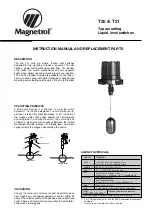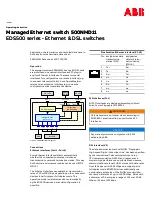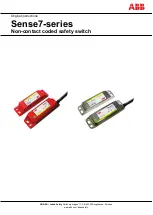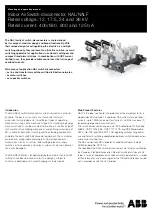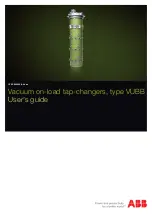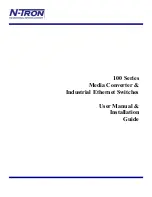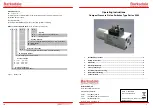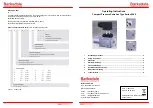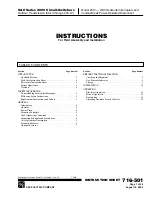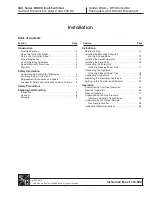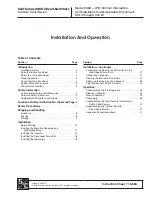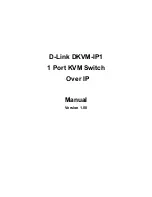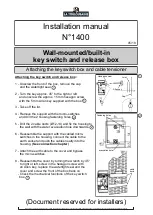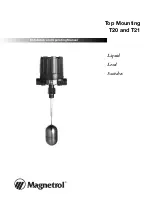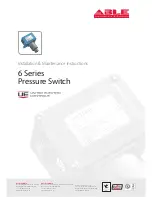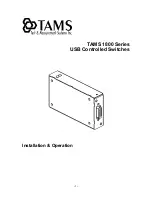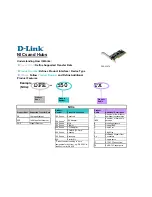
6
7. With switch housing removed, jam nuts and attraction
sleeve are accessible. Measure position of upper jam
nuts from stem end; then loosen and remove upper
jam nuts, guide washer, and attraction sleeve.
8. Loosen and adjust lower jam nuts to desired position.
Make certain jam nuts are retightened securely.
NOTE:
Use new gasket in assembly of switch housing to
chamber (Part No. 12-1301-002).
9. Test switch actuation by varying liquid level in tank or
vessel.
SWITCH DIFFERENTIAL ADJUSTMENT
cont.
CAUTION:
Instructions given are for standard base
model units which use a single magnet switch mecha-
nism only. No differential adjustment should be attempt-
ed on tandem float models in the field. Switch actuation
levels have been set at the factory to meet specific cus-
tomer specifications. Variations in actual conditions
from design conditions usually requires special control
modifications. Consult with the factory or local repre-
sentative for assistance
TROUBLE SHOOTING
Usually the fi
rst indication of improper operation is failure of
the controlled equipment to function, i.e.: pump will not start
(or stop), signal lamps fail to light, etc. When these
symptoms occur, whether at time of installation or during
routine service thereafter, check the following potential
external causes first.
— Fuses may be blown.
— Reset button(s) may need resetting.
— Power switch may be open.
— Controlled equipment may be faulty.
— Wiring leading to control may be defective.
If a thorough inspection of these possible conditions fails to
locate the trouble, proceed next to a check of the control’s
switch mechanism.
CHECK SWITCH MECHANISM
1.
Pull disconnect switch or otherwise disconnect power to
the control.
2. Remove switch housing cover.
3. Disconnect power wiring from switch assembly.
4. Swing magnet assembly in and out by hand to check
carefully for any sign of binding. Assembly should
require minimal force to move it through its full swing.
5. If binding exists, magnet may be rubbing enclosing
tube. If magnet is rubbing, loosen magnet clamp screw
and shift magnet position. Retighten magnet clamp
screw.
6. If switch magnet assembly swings freely and mechanism
still fails to actuate, check installation of control to be cer-
tain it is within the specified three (3°) degrees of vertical
(Use spirit level on side of enclosing tube in two place, 90°
apart.
7. If mechanism is equipped with a mercury switch,
examine glass mercury tube closely as previously
described in “Preventive Maintenance” section. If
switch is damaged, replace it immediately.
8. If switch mechanism is operating satisfactorily, proceed
to check sensing unit.
CHECK SENSING UNIT
1.
Re-connect power supply and carefully actuate switch
mechanism manually (using a non-conductive tool) to
determine whether controlled equipment will operate.
CAUTION:
With electrical power “on”, care should be taken
to avoid contact with switch leads and connec-
tions at terminal block.
2.
If controlled equipment responds to manual actuation
test, trouble may be located in the level sensing portion
of the control (float, stem and magnetic attraction
sleeve[s]).
NOTE:
Check fi
rst to be certain liquid is entering storage
tank or vessel. A valve may be closed or pipe line plugged.
3. With liquid in tank or vessel, proceed to check level
sensing action by removing switch housing assembly.
4. Inspect magnetic attraction sleeve(s) and inside of
enclosing tube for excessive corrosion or solids build-
up which could restrict movement, preventing sleeve(s)
from reaching field of magnet(s).
5. If differential has been changed in the field, check tight-
ness and position of the jam nuts.
NOTE:
Dif
ferential adjustment affects a change in the
amount of level travel between “switch on” and “switch off”
actuations. Do
NOT
attempt adjustment without fi
rst con-
sulting factory for assistance in computing level differential
change for your control.
6. Check float to be certain it is buoyant in the liquid (tank
or vessel must have adequate liquid level). If float is
determined to be filled with liquid or collapsed, it must
be replaced immediately. Do NOT attempt to repair a
float.
If all the components in the control are in operating condi-
tion, the trouble must be (and should be) located external
to the control. Repeat inspection of external conditions pre-
viously described.
NOTE:
When in doubt about the condition or performance
of a Magnetrol control, return it to the factory. See “Our
Service Policy” on back page.

